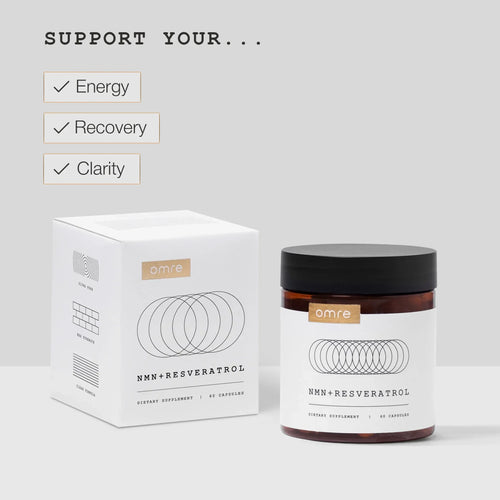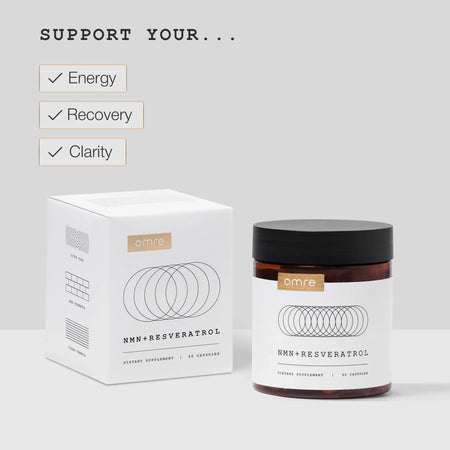Table of Contents
NMN and NR both help increase NAD+ levels, but they work in slightly different ways.
NMN is one step closer to NAD+ in the body’s conversion process, while NR has more human studies and proven absorption.
If you’re deciding between NMN and NR for energy, longevity, or cellular health, this guide breaks down their differences in structure, absorption, benefits, and safety, so you can choose the right supplement for your goals.
Cellular NAD+ booster with ultra‑pure NMN and Resveratrol, at research‑backed doses.*NMN + RESVERATROL
TL;DR
NMN and NR are both NAD+ precursors, but they differ in how the body uses them. NMN converts directly into NAD+, which may offer faster effects. NR turns into NMN first but has more clinical research in humans and better-known absorption. NMN may be better for energy and metabolism, while NR is often more affordable and widely studied. Some people take both to support different tissues and pathways.
What is NAD+ and Why Is It Important?
-v1752534724573.webp) NAD+ (nicotinamide adenine dinucleotide) is a coenzyme that plays a major role in cellular energy production and repair within human cells.
NAD+ (nicotinamide adenine dinucleotide) is a coenzyme that plays a major role in cellular energy production and repair within human cells.
As we age, NAD+ levels drop, which can lead to fatigue, slower metabolism, and signs of aging at the cellular level. Researchers have found that boosting NAD+ levels may support healthy aging, enhance cellular energy production, and improve brain function by protecting mammalian cells from decline.
One study published in Cell Metabolism showed that increasing NAD+ levels improved muscle function and mitochondrial activity in older mice, suggesting a link between NAD+ and better aging outcomes [1].
Another study found that restoring NAD+ levels improved insulin sensitivity and reduced liver fat in obese mice [2]. While most early work was done in animals, human trials are underway, and early results from NR studies have shown increased NAD+ levels in people too.
This is where NMN and NR come in; they're both precursor molecules your body uses to make NAD+.
What Is NMN?
NMN (Nicotinamide Mononucleotide) is a compound found in small amounts in foods like broccoli, avocado, and edamame. It’s one of the building blocks your body uses to create NAD+.
NMN works by converting directly into NAD+ once it's inside your human cells, helping to support processes like DNA repair and cellular energy production.
A 2019 study from Washington University even found that NMN is absorbed efficiently in mice using a special transporter protein called Slc12a8, which may also exist in humans [3].
Harvard professor Dr. David Sinclair, a leading researcher in aging, takes NMN himself. He stated in interviews and his book Lifespan that he takes NMN daily to help support his NAD+ levels and cellular health.
Human studies are still developing, but one trial in Japan found that NMN is safe and well-tolerated up to 500 mg, with no major side effects [4].
In short, NMN is a promising supplement with growing research behind it, especially for those focused on energy and healthy aging.
What Is NR?
NR (Nicotinamide Riboside) is another form of vitamin B3. Like NMN, it helps your body make NAD+, but it follows a slightly different path.
NR converts into NMN first, and then into NAD+. Even though it's one step further back, NR is highly bioavailable and has been studied in several human clinical trials.
One well-known study published in Nature Communications showed that a single dose of NR increased NAD+ levels in humans by up to 2.7 times [5]. This made NR the first NAD+ precursor proven to work in people.
Another study in overweight but otherwise healthy adults found that NR was safe and led to dose-dependent increases in NAD+, with doses ranging from 100 to 1,000 mg [6].
NR has a longer track record in human studies compared to NMN and is available in well-known supplements like Niagen.
What Is the Difference Between NMN and NR?
NMN and NR both increase NAD+ levels but differ in how they’re processed, absorbed, regulated, and priced.
Conversion path to NAD+
NR converts into NMN, which then becomes NAD+. NMN skips this extra step and converts directly into NAD+, which some researchers suggest makes it a faster and more efficient choice.
However, the difference may be small in practice and depends on how well each person absorbs these compounds.
Absorption and bioavailability
One key argument in favor of NR is its proven absorption in humans. Studies show that NR quickly raises NAD+ levels in the blood.
NMN's bioavailability was questioned for years because of its size, but the discovery of the Slc12a8 transporter in mice suggests it might be absorbed well in the gut.
The Cell Reports study that identified this transporter showed NMN was rapidly absorbed and raised NAD+ levels in multiple tissues [7]. But more human studies are still needed to confirm this fully.
Legal status and FDA regulation
In the United States, NR is legally sold as a dietary supplement and included in several branded products. NMN, on the other hand, has a murkier status.
The FDA recently stated that NMN cannot be sold as a supplement because it’s being investigated as a pharmaceutical drug.
This doesn't mean NMN is unsafe; it’s a regulatory issue, but it does affect availability.
Research and safety record
NR has a longer safety record in human studies. Research shows that doses up to 1,000 mg daily are well-tolerated with minimal side effects like nausea or flushing.
NMN also appears to be safe, but fewer human studies are available, and most of the data come from animals or small-scale trials.
Price and availability
NMN usually costs more than NR, mainly because adding the phosphate group to make NMN adds a manufacturing step. NR is easier to find in stores and often comes in combination formulas.
Which Precursor Gets Into Cells Better?
A common debate in the NMN vs NR conversation is which one actually gets into your cells more efficiently. This matters because NAD+ needs to be produced inside your cells to be useful.
For a long time, scientists believed NR had the upper hand, mainly because it’s a smaller molecule and has a known transporter that helps it enter cells easily.
Human studies, like the one published in Nature Communications, showed NR is well-absorbed and quickly boosts NAD+ levels in the blood [8].
However, this changed in 2019 when a team from Washington University School of Medicine discovered a special transporter protein called Slc12a8 in the small intestines of mice. This protein actively helps NMN enter cells directly, bypassing the need to first convert to NR [9].
Genetic data also suggest humans have the Slc12a8 gene, with strong expression in the small intestine and colon, although human-specific studies on its function are still limited. This opens the door for NMN to be a direct NAD+ precursor, not just a molecule that must first revert to NR.
So, while NR is still the most studied and confirmed in human trials, NMN might not be as limited in absorption as previously thought.
More human research is needed to fully compare their cellular uptake side by side.
NMN + RESVERATROL
Cellular NAD+ booster with ultra‑pure NMN and Resveratrol, at research‑backed doses.*
Health Benefits: NMN vs NR
-v1752534762792.webp) Both NMN and NR help increase NAD+ levels, which supports a wide range of biological functions. Their benefits often overlap, but here’s a closer look at what each may support based on current research.
Both NMN and NR help increase NAD+ levels, which supports a wide range of biological functions. Their benefits often overlap, but here’s a closer look at what each may support based on current research.
Anti-aging and longevity
Both NMN and NR may help slow age-related decline by supporting DNA repair and cellular function. NMN, in particular, has been shown in mice to improve mitochondrial function, increase skeletal muscle strength, and delay aging markers [10].
NR has also shown potential benefits in humans. A clinical study published in Cell Reports found that NR supplementation improved markers linked to biological aging and oxidative stress in older adults [11].
Metabolic and blood sugar support
NMN has shown promise in improving insulin sensitivity and glucose tolerance, particularly in overweight or prediabetic individuals. A study found NMN supplementation improved muscle insulin sensitivity in postmenopausal women [12].
NR has also been studied for its effect on metabolism. In one clinical trial, NR supplementation in obese men improved lipid metabolism and reduced certain markers of inflammation, although glucose metabolism effects were less consistent [13].
Brain health and cognitive function
NR may help with brain function by supporting mitochondrial health and restoring NAD+ levels in the brain, which can decline with age. Animal studies show improved cognitive function and resistance to neurodegeneration with NR supplementation [14].
NMN has similar effects in mice. One study found NMN improved memory and increased cerebral blood flow, possibly reducing risk factors for age-related cognitive decline [15].
Heart and cardiovascular health
Both NMN and NR appear to support cardiovascular health. NMN helps enhance blood vessel function and reduce arterial stiffness in older animals [16].
NR, in human studies, has been linked to lower blood pressure and improved endothelial function, key factors in heart disease prevention [17].
Safety and Side Effects
Both NMN and NR are generally safe when taken at recommended doses, with only mild side effects reported in clinical studies.
The most common complaints include nausea, bloating, or flushing, usually at higher doses. No serious side effects have been confirmed so far in human trials.
Safety of NMN
NMN has been tested in several animal and small human studies. In a 2020 Japanese trial, healthy men took up to 500 mg of NMN daily without side effects, showing good short-term safety [18].
Animal studies have gone even further. Mice and rats have tolerated much higher doses of NMN (up to 300–500 mg/kg) with no signs of toxicity.
Still, long-term human studies are limited, and it's best to start with a lower dose and increase gradually while monitoring how your body responds.
Safety of NR
NR has a more extensive human safety record. The FDA recognizes Niagen, a branded form of NR, as GRAS (Generally Recognized as Safe). In human trials, doses up to 1,000 mg per day have been well-tolerated for up to 12 weeks [19].
The most common side effects reported in studies are mild and include nausea, headache, or fatigue, typically when taking higher doses.
Overall, NR has a strong reputation for safety and has been used in several published clinical trials across diverse age groups.
Dosage and How to Take Them
NMN and NR supplements are typically taken daily and come in capsules, powders, or sublingual forms. While there’s no universal dosage, studies suggest a range that is both effective and safe for most adults.
How to take NMN
Most people start with 250 mg to 500 mg of NMN daily, which has been shown in studies to safely raise NAD+ levels. Some users gradually increase their dose to 1,000 mg, depending on their needs and how their body responds.
In animal studies, even higher doses have been well-tolerated, but such amounts haven’t been fully studied in humans yet.
You can take NMN in the morning, ideally on an empty stomach or with water, since your body’s natural NAD+ production tends to peak during the daytime.
NMN is often combined with Resveratrol to support sirtuin activity, which depends on NAD+ to function properly. This combo is popular among those focused on longevity and healthy aging.
How to take NR
The typical dose of NR ranges from 250 mg to 1,000 mg per day. Most clinical studies use 300 mg to 500 mg, which has been shown to effectively raise NAD+ levels without significant side effects.
NR is available in capsule form and is usually taken once daily with or without food. Unlike NMN, there’s no strong consensus on the best time of day to take NR, so it often comes down to personal preference.
Some people pair NR with TMG (trimethylglycine) or quercetin to support methylation pathways or enhance overall antioxidant protection, though this isn’t required.
Which Supplement Should You Choose?
NMN may be better if you want faster NAD+ conversion and support for energy, metabolism, or aging. It’s one step closer to NAD+ and may offer a direct cellular benefit.
NR might be the right choice if you prefer a supplement with more human trials and a lower price tag. It’s widely available, well-studied, and generally easier to access.
Some people take both over time or alternate between them to support different tissues.
You can also decide based on added ingredients like resveratrol or pterostilbene, which may enhance results.
Ready to try NMN for yourself? If you're looking for a clean, well-formulated option backed by real science, Omre’s NMN + Resveratrol is a smart place to start.
If you're looking for a clean, well-formulated option backed by real science, Omre’s NMN + Resveratrol is a smart place to start.
You get a research-based dose of NMN plus Resveratrol to support sirtuins and healthy aging, all in one simple routine.
Explore Omre NMN + Resveratrol and see if it fits your goals.
Conclusion
Both NMN and NR support healthy aging by raising NAD+ levels, fueling energy, metabolism, and brain function at the cellular level.
NMN may be the better choice if you're focused on fast conversion and longevity support. NR stands out for its strong safety profile and broader availability.
Whichever you choose, consistency matters. Look for clean formulas, transparent labeling, and research-backed doses to get the most out of your supplement routine.
FAQs
Can you take NMN and NR together?
Yes, many people choose to take NMN and NR together. Combining them might offer broader cellular support since they both support NAD+ production through slightly different pathways. However, there’s limited research on taking both simultaneously, so it’s a good idea to start with one and see how your body responds before combining.
How much does NMN cost?
NMN supplements usually cost between $1.50 to $2 per 500 mg, depending on the brand, purity, and where it's made. It's typically more expensive than NR because producing NMN involves an extra step in the manufacturing process.
How much does NR cost?
NR tends to be a bit more affordable, with prices ranging from $1 to $1.50 per 500 mg. Some bulk or subscription options, especially for well-known brands, may lower the cost further.
Where can I buy NMN and NR?
You can find both NMN and NR supplements online through trusted retailers. NR is usually easier to find in physical stores and on platforms like Amazon. NMN is still widely available, though its availability might vary depending on the country and local regulations.
Are there natural sources of NMN or NR in food?
Yes, small amounts of both NMN and NR can be found in certain foods. NMN is found in things like broccoli, cabbage, avocado, and edamame. NR is present in trace amounts in milk and yeast. But the levels in food are very low, so supplements are usually needed to see any noticeable effect.
Do different tissues prefer NMN or NR?
Yes. Some research suggests different tissues may absorb NMN and NR differently. For example, liver cells may prefer NR, while the gut and small intestine may favor NMN due to the presence of the Slc12a8 transporter. This is why some people combine both to support a wider range of tissues and functions.





